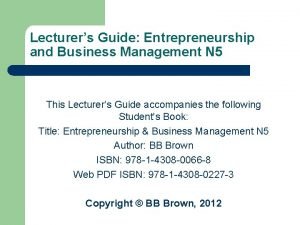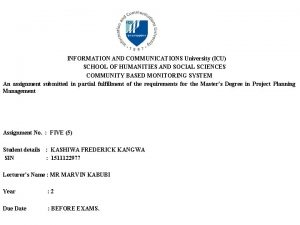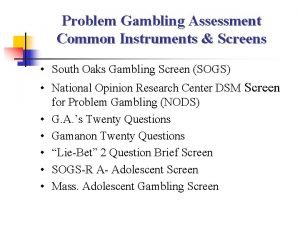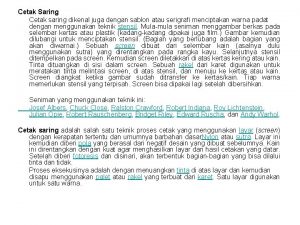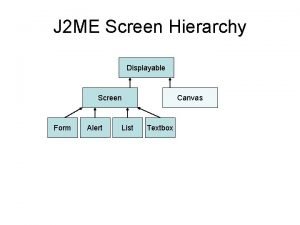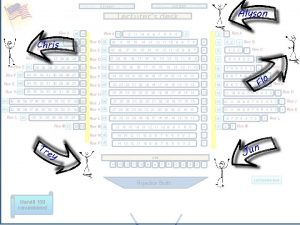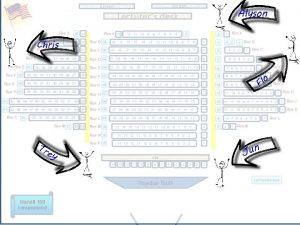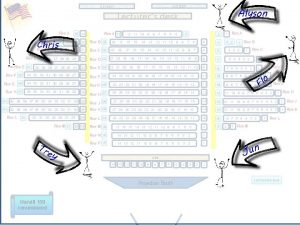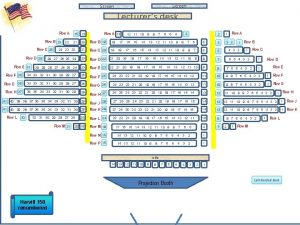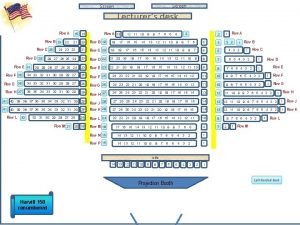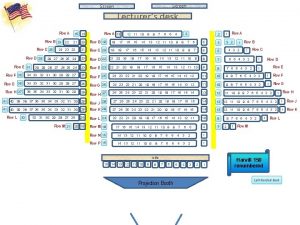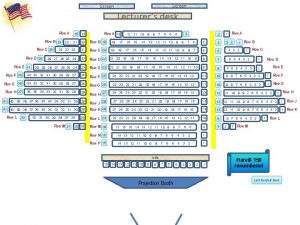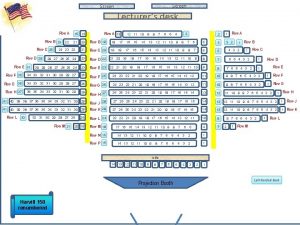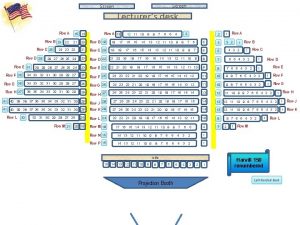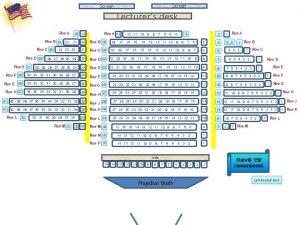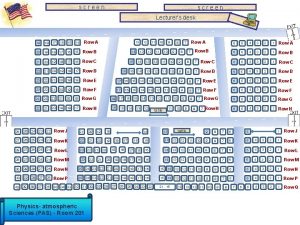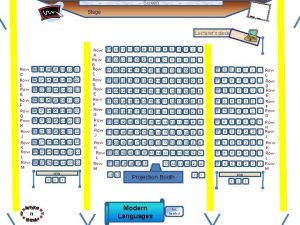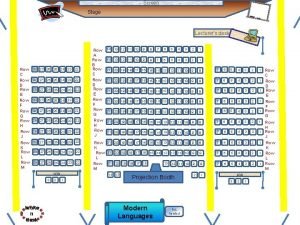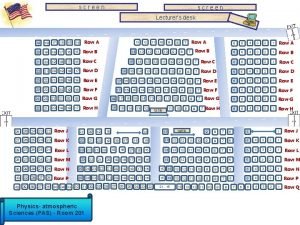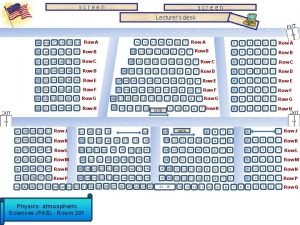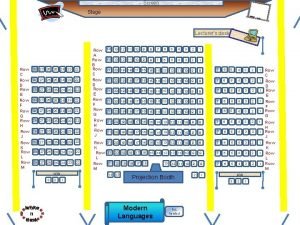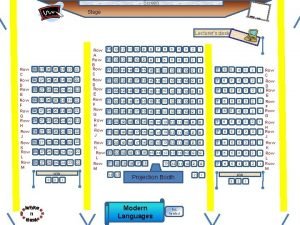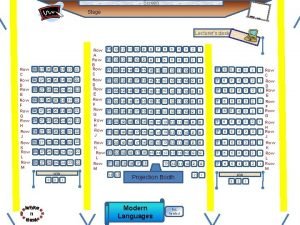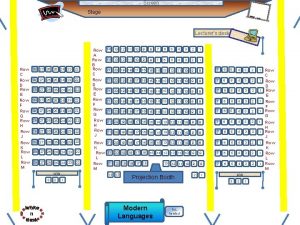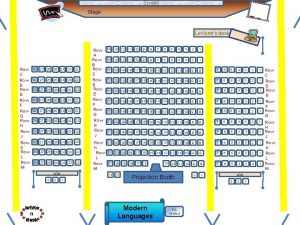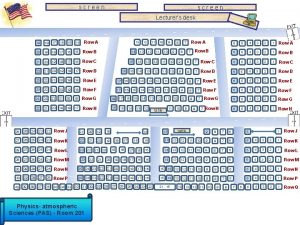Screen Alyson Lecturers desk Row A Chris Row









































- Slides: 41

Screen Alyson Lecturer’s desk Row A Chris Row C Row B Row A 15 14 12 11 10 13 20 Row B 19 24 23 22 21 Row C 20 19 28 27 26 25 24 23 Row D 22 21 20 19 30 29 28 27 26 25 24 23 Row E 23 22 21 20 19 35 34 33 32 31 30 29 28 27 26 Row F 25 35 34 33 32 31 30 29 28 27 26 Row G 37 36 35 34 33 32 31 30 29 28 41 40 39 38 37 36 35 34 33 32 31 30 25 Row D Row E Row F Row G Row H Row L 33 31 29 23 22 21 Tr ey 21 8 7 6 5 Row A 2 1 3 2 Row B 8 7 6 5 4 12 11 10 9 8 7 6 5 4 3 2 1 24 23 22 21 20 19 18 17 16 15 14 13 12 11 10 9 8 7 6 5 4 3 2 25 24 23 22 21 20 19 18 17 16 15 14 13 12 11 10 9 8 7 6 5 4 3 2 Row H 27 26 25 24 23 22 21 20 19 18 17 16 15 14 13 12 29 Row J 28 27 26 25 24 23 22 21 20 19 18 17 16 15 14 13 12 11 10 9 8 7 6 5 4 3 2 1 Row J 29 Row K 28 27 26 25 24 23 22 21 20 19 18 17 16 15 14 13 12 11 10 9 8 7 6 5 4 3 2 1 Row K 25 Row L 24 23 22 21 20 19 18 17 16 15 14 13 12 11 10 9 20 19 Row M 18 4 3 Row N 15 14 13 12 11 10 9 8 7 6 5 4 3 2 1 Row P 15 14 13 12 11 10 9 8 7 6 5 4 3 2 1 4 3 18 17 18 16 17 15 16 18 14 15 17 18 13 14 13 16 17 12 11 10 15 16 14 15 13 12 11 10 14 17 16 15 14 13 12 11 10 9 13 8 7 6 5 table 14 13 12 11 10 9 8 7 6 Projection Booth Harvill 150 renumbered 3 4 9 32 31 30 29 28 27 26 Row M 9 5 2 1 1 Row C Row D Row E o Fl 1 Row F 1 Row G 11 10 9 8 7 6 5 4 3 2 2 1 1 1 Row L Row M Jun 1 Left handed desk Row H

e v a h u o y f i d e r Even e t s i g e r t e y n a c t o u n o y r e k c i l c r e u t a yo p i c i t r a p still The Gre e She n ets

Introduction to Statistics for the Social Sciences SBS 200 - Lecture Section 001, Fall 2018 Room 150 Harvill Building 10: 00 - 10: 50 Mondays, Wednesdays & Fridays. http: //www. youtube. com/watch? v=o. SQJP 40 Pc. GI

Everyone will want to be enrolled in one of the lab sessions e u n i t n o k c e e s b w La this

Schedule of readings Before next exam (September 21) Please read chapters 1 - 5 in Open. Stax textbook Please read Appendix D, E & F online On syllabus this is referred to as online readings 1, 2 & 3 Please read Chapters 1, 5, 6 and 13 in. Plous Chapter 1: Selective Perception Chapter 5: Plasticity Chapter 6: Effects of Question Wording and Framing Chapter 13: Anchoring and Adjustment



Overview Frequency distributions The normal curve Challenge yourself as we work through characteristics of distributions to try to categorize each concept as a measure of 1) central tendency 2) dispersion or 3) shape Mean, Median, Mode, Trimmed Mean Skewed right, skewed left unimodal, bimodal, symmetric

Dot Plot R w e i ev

Let’s create a distribution of the baseball players in the University of Arizona Baseball team Diallo is 6’ 0” Diallo 5’ 8” 5’ 10” 6’ 2” 6’ 4” R w e i ev

Let’s create a distribution of the baseball players in the University of Arizona Baseball team Diallo is 6’ 0” Preston is 6’ 2” Preston 5’ 8” 5’ 10” 6’ 2” 6’ 4” R w e i ev

Let’s create a distribution of the baseball players in the University of Arizona Baseball team Diallo is 6’ 0” Preston is 6’ 2” Hunter Mike is 5’ 8” Mike 5’ 8” Hunter is 5’ 10” 6’ 2” 6’ 4” R w e i ev

Let’s create a distribution of the baseball players in the University of Arizona Baseball team Diallo is 6’ 0” Preston is 6’ 2” Mike is 5’ 8” Hunter is 5’ 10” Shea is 6’ 4” 5’ 8” 5’ 10” 6’ 2” 6’ 4” David is 6’ 0” R w e i ev

Let’s create a distribution of the baseball players in the University of Arizona Baseball team R w e i ev

Measure of central tendency: describes how scores tend to cluster toward the center of the distribution Normal distribution In all distributions: mode = tallest point median = middle score mean = balance point In a normal distribution: mode = mean = median R w e i ev

Measure of central tendency: describes how scores tend to cluster toward the center of the distribution Positively skewed distribution In all distributions: mode = tallest point median = middle score mean = balance point In a positively skewed distribution: mode < median < mean Note: mean is most affected by outliers or skewed distributions

Measure of central tendency: describes how scores tend to cluster toward the center of the distribution Negatively skewed distribution In all distributions: mode = tallest point median = middle score mean = balance point In a negatively skewed distribution: mean < median < mode Note: mean is most affected by outliers or skewed distributions

Mode: The value of the most frequent observation Bimodal distribution: Distribution with two most frequent observations (2 peaks) Example: Ian coaches two boys baseball teams. One team is made up of 10 -year-olds and the other is made up of 16 -year-olds. When he measured the height of all of his players he found a bimodal distribution

Frequency Remember… 10 20 30 Note: Always “frequency” 40 50 60 70 80 Score on Exam 90 100 Note: Label and Numbers

Overview Frequency distributions The normal curve Challenge yourself as we work through characteristics of distributions to try to categorize each concept as a measure of 1) central tendency 2) dispersion or 3) shape Mean, Median, Mode, Trimmed Mean Standard deviation, Variance, Range Mean Absolute Deviation Skewed right, skewed left unimodal, bimodal, symmetric

Variability Some distributions are more variable than others 5’ 5’ 6” 6’ 6’ 6” 7’ What might this be? Let’s say this is our distribution of heights of men on U of A baseball team Mean is 6 feet tall What might this be? 5’ 5’ 6” 6’ 6’ 6” 7’

Dispersion: Variability Some distributions are more variable than others A 5’ 5’ 6” 6’ 6’ 6” 7’ Range: The difference between the largest and smallest observations Range for distribution A? B Range for distribution B? 5’ 5’ 6” 6’ 6’ 6” 7’ C 5’ Range for distribution C? The larger the variability the wider the curve tends to be 5’ 6” 6’ 6’ 6” 7’ The smaller the variability the narrower the curve tends to be

Variability 5’ 5’ 6” 6’ 6’ 6” 7’ 7’ 7’ The larger the variability the wider the curve the larger the deviations scores tend to be The smaller the variability the narrower the curve the smaller the deviations scores tend to be But what is a “deviation score”?

Deviation scores Diallo is 0” Distribution of the baseball players: Deviation scores Diallo is 6’ 0” Diallo’s deviation score is 0 6’ 0” – 6’ 0” = 0 Diallo 5’ 8” 5’ 10” 6’ 2” 6’ 4”

Deviation scores Distribution of the baseball players: Deviation scores Diallo is 0” Preston is 2” Diallo is 6’ 0” Diallo’s deviation score is 0 Preston is 6’ 2” Preston 5’ 8” 5’ 10” 6’ 2” Preston’s deviation score is 2” 6’ 2” – 6’ 0” = 2 6’ 4”

Deviation scores Distribution of the baseball players: Deviation scores Diallo is 0” Preston is 2” Mike is -4” Hunter is -2 Diallo is 6’ 0” Diallo’s deviation score is 0 Hunter Preston is 6’ 2” Preston’s deviation score is 2” Mike is 5’ 8” Mike’s deviation score is -4” 5’ 8” 5’ 10” 6’ 2” 6’ 4” 5’ 8” – 6’ 0” = -4 Hunter is 5’ 10” Hunter’s deviation score is -2” 5’ 10” – 6’ 0” = -2

Deviation scores Distribution of the baseball players: Deviation scores David Shea Diallo is 0” Preston is 2” Mike is -4” Hunter is -2 Shea is 4 David is 0” Diallo’s deviation score is 0 Preston’s deviation score is 2” Mike’s deviation score is -4” Hunter’s deviation score is -2” Shea is 6’ 4” 5’ 8” 5’ 10” 6’ 2” 6’ 4” Shea’s deviation score is 4” 6’ 4” – 6’ 0” = 4 David is 6’ 0” David’s deviation score is 0 6’ 0” – 6’ 0” = 0

Deviation scores Distribution of the baseball players: Deviation scores David Shea Diallo is 0” Preston is 2” Mike is -4” Hunter is -2 Shea is 4 David is 0” Diallo’s deviation score is 0 Preston’s deviation score is 2” Mike’s deviation score is -4” Hunter’s deviation score is -2” Shea’s deviation score is 4” David’s deviation score is 0” 5’ 8” 5’ 10” 6’ 2” 6’ 4”

Deviation scores Distribution of the baseball players: Deviation scores 5’ 8” 5’ 10” 6’ 2” 6’ 4” Diallo is 0” Preston is 2” Mike is -4” Hunter is -2 Shea is 4 David is 0”

Deviation scores Distribution of the baseball players: Deviation scores 5’ 8” 5’ 10” 6’ 2” 6’ 4” Diallo is 0” Preston is 2” Mike is -4” Hunter is -2 Shea is 4 David is 0”

Deviation scores Distribution of the baseball players: Deviation scores 5’ 8” 5’ 10” 6’ 2” 6’ 4” Diallo is 0” Preston is 2” Mike is -4” Hunter is -2 Shea is 4 David is 0”

Deviation scores How to find the average deviation Diallo is 0” Preston is 2” Mike is -4” Hunter is -2 Shea is 4 David is 0” Mike Hunter 5’ 8” 5’ 10” 6’ 2” 6’ 4” How do we find the average height? Σx = average height N How do we find the average spread? Preston Σ(x - µ) = average deviation N Σ (x - µ) = ? 5’ 8” 5’ 9” 5’ 10’ 5’ 11” 6’ 0” 6’ 1” 6’ 2” 6’ 3” 6’ 4” - 6’ 0” = - 4” 6’ 0” = - 3” 6’ 0” = - 2” 6’ 0” = - 1” 6’ 0 = 0 6’ 0” = + 1” 6’ 0” = + 2” 6’ 0” = + 3” 6’ 0” = + 4” Σ(x - x) = 0 Σ(x - µ) = 0 Diallo

Deviation scores How to find the average deviation Diallo is 0” Preston is 2” Mike is -4” Hunter is -2 Shea is 4 David is 0” Σx- x=? 5’ 8” Big proble m 5’ 10” 6’ 2” 6’ 4” This is called “sum of Square the squares” deviations Σx N 2 Σ(x - µ) N 2 Σ(x - x) 2 Σ(x - µ) 5’ 8” 5’ 9” 5’ 10’ 5’ 11” 6’ 0” 6’ 1” 6’ 2” 6’ 3” 6’ 4” - 6’ 0” = - 4” 6’ 0” = - 3” 6’ 0” = - 2” 6’ 0” = - 1” 6’ 0 = 0 6’ 0” = + 1” 6’ 0” = + 2” 6’ 0” = + 3” Big 6’ 0” = + 4” proble - x) = 0 m Σ(x - µ) = 0

How to find the average deviation Mean: The average value in the data Standard deviation: The average amount scores deviate on either side of their mean Mean is a measure of typical “value” (where the typical scores are positioned on the number line) Standard deviation is typical “spread” or typical size of deviations or distance from mean – can never be negative

Standard deviation: The average amount by which observations deviate on either side of their mean These would be helpful to know by heart – please memorize these formula

Standard deviation: The average amount by which observations deviate on either side of their mean What do these two formula have in common? d dar n a t S e ianc r : t a c v Fa d = e r Fun a squ n o i t devia

Standard deviation: The average amount by which observations deviate on either side of their mean Note this is for population standard deviation & variance What do these two formula have in common? Note this is for sample standard deviation & variance

Standard deviation: The average amount by which observations deviate on either side of their mean “Sum of Squares” You know by heart – you’ve memorized these formula

Standard deviation: The average amount by which observations deviate on either side of their mean “degrees of freedom” You know by heart – you’ve memorized these formula

Standard deviation: The average amount by which observations deviate on either side of their mean Deviation scores Diallo is 0” Preston is 2” Mike is -4” Hunter is -2 Shea is 4 David 0” Remember, it’s relative to the mean Generally, (on average) how far away is each score from the mean? Based on difference from the mean Please memorize these Mean Diallo Mike Preston Shea

 Is row row your boat a binary form
Is row row your boat a binary form Raquel anido
Raquel anido Ebm n5
Ebm n5 Lecturers without borders
Lecturers without borders Information and communications university
Information and communications university Alyson russell
Alyson russell Washington naval conference
Washington naval conference Alyson klein
Alyson klein Alyson mahar
Alyson mahar Screen small screen offscreen
Screen small screen offscreen Betty botter
Betty botter Sql
Sql Obs screen recorder
Obs screen recorder Screen point to ray unity
Screen point to ray unity Saring sutera
Saring sutera Screen output and keyboard input
Screen output and keyboard input Gif screen
Gif screen Electric grading screen
Electric grading screen Characout
Characout How is a window screen similar to a cell membrane
How is a window screen similar to a cell membrane Barney os powerpoint download
Barney os powerpoint download Sumbu koordinat pada java menyatakan titik (0,0) pada ...
Sumbu koordinat pada java menyatakan titik (0,0) pada ... Infrared touch screen advantages and disadvantages
Infrared touch screen advantages and disadvantages Screen-reader-response
Screen-reader-response Screen line
Screen line Functional movement screen johnson county
Functional movement screen johnson county First screen feasibility analysis
First screen feasibility analysis Minnesota cognitive acuity screen
Minnesota cognitive acuity screen Postpartum stomach pain
Postpartum stomach pain Jrvr stock
Jrvr stock Touchless touchscreen user interface
Touchless touchscreen user interface Screen design and layout in hci
Screen design and layout in hci Stevenson screen unit of measurement
Stevenson screen unit of measurement Screen truepress 344
Screen truepress 344 Intensifying screen layers
Intensifying screen layers Screen section in cobol
Screen section in cobol Cetak saring dikenal dengan …
Cetak saring dikenal dengan … Hxdef100.exe
Hxdef100.exe Sam hurst touch screen
Sam hurst touch screen Screen hierarchy
Screen hierarchy Head loss through bar screen
Head loss through bar screen Menu screen design
Menu screen design


